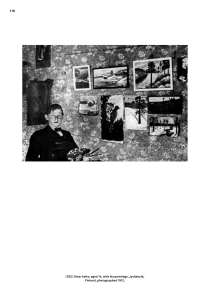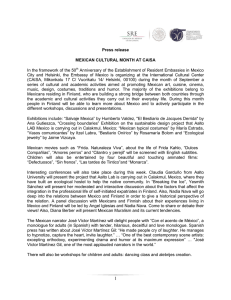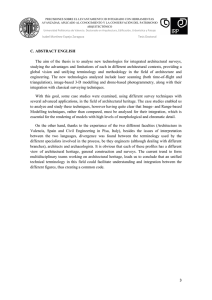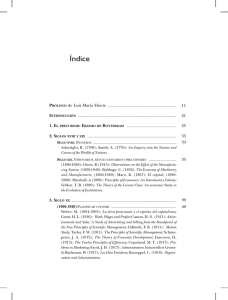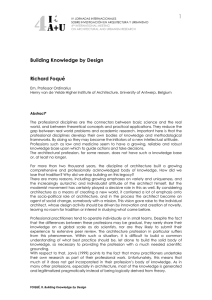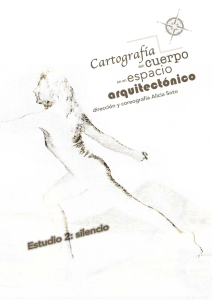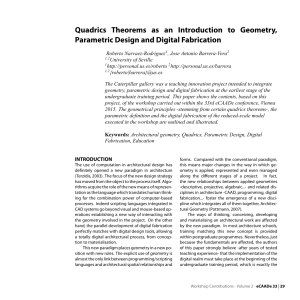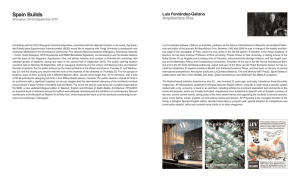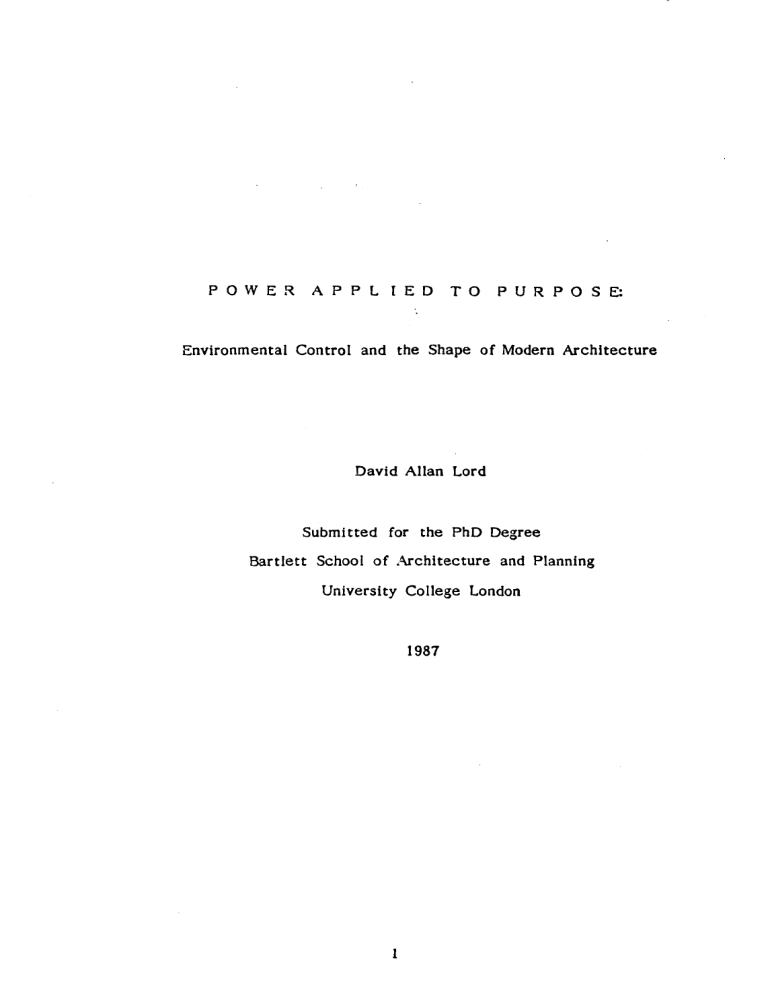
POWER APPL lED TO PURPOSE: Environmental Control and the Shape of Modern Architecture David Allan Lord Submi tted for the PhD Degree Bartlett School of Architecture and Planning University College London 1987 1 7. - -Alvar -As} to: - -ellmate-and-M!taphor The norms should not only require that each dwelllng get sun; the angle of Incidence should also be decided, to, let us say, one degree's leeway. Aa I to, 1978. Alvar Aalto was self-assured In his ablllty to combine romance with technology in buildings that are pragmatic yet Intensely personal. His achievements Include the seminal Paimio Sanatorium (1929-33), in which he sought environmental perfection by using materials and arranging spaces in such a way as to give height. openness, light and air along with the well-designed provision of services. Throughout, his designs show an understanding of environmental management, Including the manipulation and control of light, heat and sound. Aalto was not given to writing nor to the comprehensive development of a theory describing his design method. The written record of his thought Is relatively small when compared to that of Wright, Le Corbusier and Kahn. However, the attitudes he held towards art. technology and architectural problem-solving were widely reported. He makes continual reference to nature In both his recorded statements and in his designs. He was Interested In the way that his architectural concepts evolved and he Illuminated this process by poetic allegories such as the following one which appeared In 1947: ••• architecture and Its details are connected in a way with biology. They are perhaps llke large salmon or trout. They are not born mature, they are not even born In the sea or a body of water where they will normally live. They are born many hundreds of miles from their proper living environment. Where rivers are but streams, small shining 165 bodies of water between the mountains, under the glaciers' first melting water drops, there they are born, as far from their normal environment as man's spiritual life and Instincts are from his dally work. [Aalto, 1978, p 97-98.) Aalto's approach to technological expression and refinement Is based on a deep regard for biological prototypes. He believed that the best examples of architectural standardisation were contained In natural, living systems, an idea which revealed the Influence of Oriental thinking and which paralleled some of the ideas of Wright. His architectural aesthetic owed its origin more to nature than to pure technology which had 'found Its way Into architecture'. He strongly held that architectural problems cannot generally be solved by technical means. His architecture avails of technology, but the way It does so is to aim at harmonising technical and natural characteristics. He called architecture a 'supra-technical' form of creation based on the harmonisation of innumerable functional forms: A bullding Is In no wise a technical problem -- It is an 'arch-technical' problem. Technical design methods cannot therefore be adapted to suit It. The standardisation In this Instance should be arch-technical. [Aalto, 1978, p 32.) He cited examples from the past where architecture was treated as a sort of technical speclallsatlon. These attempts to apply technology to archl tecture resul ted In failures which had 'grave SOCial repercussions:' His favourite example was Thomas Alva Edison who spent years attempting to solve an architectural problem -- the standard house -- using technical methods. This led Edison after years of effort to the only real defeat he experienced In his lifetime. His designs were based on an awareness of the relationship of shelter and human activities to the surrounding elements. This concern surfaced in his dedication to solving a range of environmental issues, from Ughting, heating, ventilation and air pollution to acoustics. As early as 1930, he discussed the meaning of 'air quality' In relation to ventilation: 166 The biological conditions for human Ilfe are, among others, air, light, and sun. Air does not have to do with the sIze of the rooms or their number. It is an Independent concept. We can surely build a dwelling with a large cubic footage of air without using the floor area uneconomically and affecting the ceiling heIght. The aIr space Is a question of ventilation. On the other hand one must give a great deal of consideration to the air's quality. And this Is a question that is dependent on the city's internal organisation, the town plan. [Aalto, 1978, p 32.] His Interest and expertise in town planning is less well known than his architectural work, however it Is reievant here because It reveals his insIght Into problems resulting from the rapid assimilation of technology in the form of the automobile, and illustrates his concern about the impact of technology on environmental quality. IndIrectly, he commented about man's relationship to technology in the Annual R.I.B A. Discourse in 1957. The mood Is one of nostalgia for tIme lost, when things were simpler and the relationship of man to nature was more direct. In a way, It is remIniscent of Seneca, when he longed for less dependence on technology: Our streets and cIties were desIgned for completely dIfferent purposes -- as was the nice Boulevard Itallen, for horse traffic, a few horses here and there. Now it's full of automobiles -- and we know they are ••• putting out a very dangerous heavy gas which lies on the streets ••• today we are paying a very high price for our inab1llty to build a new traffic system in which' pedestrians and automobtles are far away from one another, not to speak of housIng and living. [R.I.B.A. Annual Discourse, 1957.] He didn't lose sight of the many technical and human Issues in architectural deSign, and the nature of solving the complex problems often arising from contradictory requirements. He described these difficulties and their solution In his own professional practice. When he had to resolve an architectural problem, he was invariably overcome by the thought of Its realisation. 167 He said that what he needed was a sort of '3 a.m. courage,' due to the weighty Importance and difficulties In resolving the different elements at the time of conception. He Included among these elements the social, human, technical and economic requirements side by side with the psychological factors and a concern for each Individual and each group, their rhythm and internal friction. These elements became so numerous that they formed 'an entanglement,' not lending itself to methods of rational resolution. The resultant complexity initially prevented the basic architectural idea from ,taking shape. [Aalto, 1957 p 138-139.] Aalto called on the help of poetry -- an expression from Strindberg -- to describe his feeling for irreconcilable contrasts: Goldpower at the Ironsprlng Coppersnake under silver linden that Is the lady of the wood's riddle that is yours and mine. He Interpreted this poem by Strindberg to mean that apparently irreconcilable opposites may at last in one way or another be brought into harmony. He felt that Strindberg's way of placing the opposites next to each other hinted at the manner In which art and the purely material world could be united. Under these Circumstances, he claimed to work In a completely Irrational way. His technique was to forget the whole entanglement of problems, clear It from his head and occupy himself with painting abstract art. When he resumed designing, he allowed himself to be guided purely by instinct -- and, suddenly, the basic concept would appear and the different, often contradictory, elements would be put In harmony. 168 He gave an example of Irreconcilable differences In environmental tempering being harmonlsed In the design of his churches. The nature of the geographical and local siting, the building materials for the walls, roof, heating system, ventilation, llghting, and surface treatment he considered to be basically Independent of each other. In addition to being Independent considerations, they are also often In conflict with one another, and yet It Is necessary to bring them Into harmony. According to Aalto, only if and when this harmony Is achieved does the building become a 'cultural factory' of permanent value. In the Imatra Church, for Instance, one Is initially greeted with a cold, white, Protestant light; pure, clear rational confirmation of the presence of religion without belief. The resolution of confllctlng environmental variables occurs at the junction of roof and wall. The acoustic curve of the cel1lng signals the undulatory nature of the roof, pinched together at the juncture of windows, sliding door and ventilation equipment (Fig. 7.1). As with the design of a church, he felt that nearly every design task involved thousands of different antagonistic elements, which can be forced into a functional harmony only by man's will. This harmony for Aalto could not be achieved by other than artistic means. The individual technical and mechanical elements received their definite value only by artistic will. He felt strongly that a harmonious result could not be achieved via calculations, or with the help of statistical data or probability studies: There are statistically based methods and some kind of Gallup system with whose help it has been attempted to achieve a harmonious whole. There is, for example, an enormous hospital, recently built, based on the movement patterns of the staff, in the hopes of simpllfying the 169 biodynamic movements of the people working In the building. The results have shown themselves to be totally unsuccessful. It was an attempt to achieve a total solution relying on a subordinate factor. [Aalto, 1978, p 40. J Aalto once heard a student present a thesis concerning a children's hospital. The student had attempted to find the overall solution not only through one secondary method but through many. The analysis of movement patterns took half an hour of the speaker's time. There were the space needs for children of different ages, different light angles in the window systems, easy maintenance of surfaces, etc. Aalto considered all of these to be good things In themselves If one understands them as subordinate elements, but they were In this case not sufficient to create a humane environment or a functioning whole. When the student had finished counting up all these methods and presented his technical solutions for all the cases, Aalto said: You have apparently stlll left out at least one possibility. How would the building and the sick children in It function if a wild lion jumped in through one of the windows? Would the dimensions be suitable in such a case? [Aalto, 1978, p 127-128.1 The answer was a deep silence in the whole auditorium. Only the laugh of an experienced pediatrics professor from Harvard couid be heard. His Interest in the metaphorical power of bIology and nature ultimately referred to the form-giving quallty of sunllght and its central relationship to the shaping of his architecture. This dedication to the strength of forms derived from solar geometry was pursued with precision and attention to detail: Light and sun. Under extreme conditions one can no longer leave the dwelling's access to the sun to chance. Light and air are such important preconditions for living that the haphazard conditions that prevail today must be changed. 170 sun; the angle of incidence should also be decided, to, let us say, one degree's leeway. The sun Is a source of energy; but only if we use It In a scientific way and In exact quantities wtll It become, under all circumnstances, a posltlve factor for the biodynamic concept that involves the famUy's and the single individual's life within the dwelllng's walls. In a flftysquare meter dwell1ng we don't have, In this regard, the sl1ghtest margin to be left to chance, nor can we afford to allow the sun's and the light's energy to remain unused. [Aalto, 1978, p 32.] His Interest In the sun extended to the potential of solar energy for heating. His studio at the experimental house at Muuratsalo 'crowned' the entire group of buildings. heating system of the other bull dings. It was not connected to the It was a separate pavlllon which was an experiment with solar heating such that wall and roof surfaces, which accumulated solar heat, were Independent of the building's other parts. The whole complex of bulldings at Muuratsalo is dominated by the fire that burns at the center of the patio and whIch, from the point of view of practicality and comfort, serves the same purpose as a campfire In a winter camp. The glow from the fire and its reflections from the surrounding snowbanks created for Aalto a pleasant, almost mystical feeling of warmth. [Aal to, 1978, p 116.] Although he claimed not to have a feeling for folklore that the traditions that bound him lay more in the cllmate -- Aalto acknowledged the spatial genealogy of his own designs by tracing their origin to the single, stove-heated room In a Finnish vernacular house: Most people look at the room as a standard measure for the dwelllng. In big dwelllngs there are many rooms and a kitchen. If we descend the ladder we flnally arrive at the classical Helsinki miniature dwell1ng, 'room with stove.' [Aalto, 1978, P 33.] His designs owed allegiance to both Nordic and MedIterranean precepts; two regions remote from each other geographically and 171 dlsslml1ar In cUmate, but linked by migratory patterns. There Is also a relationship of Aalto's work to contemporary architectural activity In Central Europe, where people live between the two regions and experience the difference between them, whereas In northern countries people are far from the Mediterranean region and traditionally yearn for sunshine. This Is a fundamental feeling and yearning that finds expression In AaIto's architecture. The expansive, unartlculated facades found in many of his constructions are oriented so as to catch the reflections as well as to re-dlrect horizontal rays from the cold northern sun and thus to create the Illusion of a more intense light than really exists. On the other hand, the semi-open and closed atria which are so typical of the Mediterranean area are often used in the north, too. However, their purpose there is not to offer shade as in the south, but to collect light and to provide enclosure and protection against cold winds. In using these form-giving elements, Aalto's architecture shows a transformation of features typical of the Mediterranean region, whose architectural tradition he admired. It Is fitting that his final building -- a church whIch was constructed posthumously In Italy -- is physically located near the Mediterranean but Is conceptually bound to hIs ecclesiastical forms of the North. His work Is characterised by attention to details of comfort and climate and a virtuosity of finish which was allen to his predecessors, Haering and Scharoun. The comparison of his work to theirs can be likened to the difference between anima and animus. [Slapetka, 1980, P 115.] When Aalto's works are compared with Scharoun's it seems that the difference between them Is similar to the difference between male and female. Scharoun seems to be more 172 forceful, careless, mascuUne and vlrtle, often deliberately antlaesthetic and uncomfortable, whereas Aalto always strives for a perfect aesthetic impression. Aalto pays attention to the delicate contextual placement of his buildings In their enVironment, and they exhibit a womanlike beauty and perfection of contour, with refinement and elegance In every detail, including their relationship to the harsh exterior climate. From a formal point of view, Aalto, unlike Haering and Scharoun, did not abandon the rectangular basis of his compositions, which are shaped like Japanese fans or classical Greek theatre plans. Free shapes appear only In some dominant functional aspects. Aalto did not become aware of Wright's work untll a trip to the U.S. in 1939, when he saw his buildings for the first time. Bauhaus did not interest Aalto as much as the Jugend ~ The with Its contintental origins, especially the work of Henri van de Velde. His reaction to Le Corbusler was that he was an architect who had for the most part expressed himself by writing books: ••• ~nd with books it Is as I once said in a conversation with General Talvela. He told me he doesn't read books about war, but rather about art and architecture. I confessed that I gladly read books about war but never about architecture. [Aalto, 1978, p 171. ) Aalto was cynically aware that objects which were labelled 'rational' often suffered from a noticeable lack of human qualities. Disregarding for a moment the possibility that the missing elements could be introduced merely by adding 'more form', he felt that If a closer study were made of the 'facts', the rationality of a designed object most often applies to a few of Its characteristics but not to all. Aaito thought that the origins of rational architecture were in 173 some way connected with the method of production. He used the tubular metal chair of Marcel Breuer as an example: To achieve a springy seat merely with a few bent tubes and some tightly stretched bits of leather Is In Itself a clever technical solution. It can In this regard justly be labeled rational. It can also be considered so In many other respects, primarily from a structural viewpoint. [Aalto, 1978, p 48. ) But he felt a chair has an endless series of requirements that It should fulfil and not til It fulfils all of them in a reasonable way __ even though different requirements come Into conflict with each other -- can It be regarded as a thoroughly 'rational creation. The point to be made Is that the main criterion of rationalism for Aalto was In fulfilling all the definable rational requirements so that they form a totality without conflict. He Imbued the chair with criteria for thermal and visual comfort, and In so doing, arrives at a scientific deflnltion of 'cozy': If we wish to list the requirements that these chairs do not succeed In filling we could mention the following: a piece of furniture that forms a part of a person's dally habitat should not cause excessive glare from light reflection; ditto, It should not be disadvantageous in terms of sound, sound absorption, etc. A piece that comes Into the most intimate contact with man, as a chair does, shouldn't be constructed of materials that are excessively good conductors of heat. I merely name these three criteria that the tubular metal chairs hardly fulflll. One could list a large number of additional requirements that In this particular case are not met. The main criticism against the metal chairs has been that they are not what one would call 'cozy.' this has In most cases been true, but when one uses the concept of 'coziness' to mean something totally, undefinably human and claims that only traditional formalism could create it better than this one Is on the wrong path. The criticisms, too noisy, too llght-reflective, and too good a heat conductor, are In reality scientific terms for things that when put together form the mystical concept of 'cozy.' [Aalto, 1978, p 49.] Aalto sought to arrive at a more humanely built environment by expanding the concept of 'rational.' He attempted rationally to 174 analyse more of the requirements than had been previously connected with the objects that he created. He tried to imagine all the different requirements that can contributed to the quallty of an object. These requirements formed a sort of scale, which he llkened to a series similar to a spectrum: In the red field of the spectrum lie social viewpoints, In the orange field questions connected with the production, etc., all the way to the invisible ultraviolet field, where perhaps the rationally undefinable requirements, still invisible to us, which exist in the individual human being, are hidden. Whatever the case, It Is at the end of the spectrum, where the purely human questions reside, where we Even if • • • we will make most new discoveries. • •• can find on closer analysis that an emotional concept Is among other things a sum of physically measurable quantities, we stlll will quickly find ourselves outside the realm of physics. A series of requirements that can be made of almost every object and that up to now has been given scant consideration surely belongs in the sphere of another science -- psychology. As soon as we include psychological requirements • • • then we will have already expanded the rational method to an extent that ••• has the potential of excluding inhuman results. [Aalto, 1978, p 49.] He extended his definition of function from the tubular steel chair to the Ilghting fixture, with Its more direct impact on visual comfort. He felt that the traditional forms which had been derived from candlelight chandeliers and oil lamps when expressed in the era of electricity left tradition to become kitsch. The rational designers of modernism offered mostly shiny white porcelain balls and opal cubes. While Aalto recognised the functional advantages of a closed, dust free porcelain ball with nickel hanger from a :nanufacturing viewpoint, he was well aware of Its shortcomings in 'quality of llght': What do we mean by the light's quality? Light exists for man, a phenomenon he needs without Interruption at his disposal. Properly adapted quality Is much more important than In the case of objects whose contact with humans is merely temporary: an acceptable perfection from a purely 175 technical viewpoint -- fixtures, their movable parts, their methods of manufacture, etc., have received their rational treatment but from many different vIewpoInts, their main task, lighting as man's good servant, Its adaptab1l1ty for good vision, and In general Its quality In relationship to man, has fallen behind. In thIs field, If anywhere, people have tried to Improve upon this lack wIth Inappropriate glued-on forms. English parchment shades wIth Piranesl flctures and sImilar things have had to represent hanlness.' Equally, modernism has created an enonnous nwnber of pIquant chandelIers, porcelain tube-mounted lights, soffit lighting, etc. The failure to deal rationally with vision requirements and man's psychologIcal needs Is perhaps not a sin Immediately recognised in an ordinary home. But If we go from the private home to, let us say, a hospital, where we have to deal with masses of people In a weakened condItion, we soon notice that we cannot correct any faIlIngs wIth the 'cozy' remedIes I have mentIoned. I have myself had experience of this In my practIce. It was apparent that the prevalent hospital llghtlng, opalescent white bodies of light, was highly unsuitable and above all psychically irritating, even in cases where the light fixtures' glare level was reduced to a minImum. The fixtures' prevalent placement, the classical middle-of-theceiling prInciple, had to be reVised, and general lightIng for the room arranged solely with consideratIon for the sIck person, his horizontal pOSition, etc. Each solution 15 In some way a compromise that Is most easUy discovered when one considers man in his weakest condltlon.[Aalto, 1978, p 50.1 Aalto had considered the qualitative examination of light by spectra-analytic methods. The difficulty of creatIng a light with a spectrum properly adapted to humans was increased by the fact that there was such a large quantitative difference between sunllght and the then available artificial light. He suggested that If the rational approach to design were expanded so that It included technical and hygienic needs 'all the way to that borderline where the psychological needs begin,' and if one used history as a kind of statIstIc on how man reacts to his environment, then candlelight could be considered as a rational artificial l1ght for man: 176 the candle's yellow flame and the Interior decorator lady's Inclination to glorify her light compositions with yellow silk rags come closer to the mark vis-a-vis human Instincts than the electrical technician with his luxmeter and his schematic concept of 'white light.' [Aalto, 1978, p SO.J Aalto paid homage to the Japanese culture, which, with Its Ilmited range of raw materials and forms, inculcated a virtuoso skill In creating variations and almost daily recombinations, based on natural metaphors. The contact with nature and its constantly observable change was a way of life that had great attraction for Aalto because It discouraged concepts that were to his taste too formalistic. [Aalto, 1978, pSI.] Aalto belleved that technical services formed a separate and distinct group of alements within modern building. Whlle acknowledging that the problems they solve are essentially old ones, he thought that modern technical methods freed the basic environmental systems from their old contexts and thus Increased the Internal freedom In building design. One example was the heating system; he was one of the first In FInland to use a district heating scheme by connecting several buildings through an underground piping system to a central neating plant. He was pleased also by the possiblllty of electric heating freeing buildings from dependence on each other and haJled It as one of the sources of fundamental change taking place In architecture. [Aalto, 1978, p 62.] The Paimio-Sanatoriun When he receIved the assignment for the tuberculosis sanatorium in Paimio, he was himself ill and therefore had the opportunity to make a few experiments and find out what It really felt llke to be sick. He became irritated at having to lie horizontal all the time. 177 His eyes were constantly drawn to the electric light In the room 'like moths to a lamp.' He became Intensely aware that the room conveyed neither 'balance nor calm' and he therefore decided to plan patients' rooms In such a manner as to provide a restful atmosphere for the bedridden patient. He did not use, for example, artificial ventilation, which causes a disturbing draft about the head, but designed a system that draws wanned aIr from double-paned windows (Fig. 7.2).[Aalto, 1978, p 131, 132.] The way he arrived at his environmental solutions was through a process of research, which he considered to 'resemble' scientific methods. He held that architectural research could be methodical, but the substance of it would never be solely analytical. Always there will be more of instinct and art In archItectural research. He describes the research which led to certain design conclusions for the Paimio Sanatorium: Experiments ••• were performed. Study of the relation between the individual and his quarters involved the use of experimental rooms and covered the questions of room form, colours, natural and artificial light, heating system, noise, and so on. This first experiment dealt with a person in the weakest possible condition, a bed patient. One of the specIal results discovered was the necessity for changing the colours in the room. In many other ways, the experiment showed, the room must be different from the ordinary room. This difference can be explained thus: The ordinary room is a room for a vertical person; a patient's room Is a room for a horizontal human being, and colours, lighting, heating, and so on must be designed with that in mind. Practically, this fact means that the celling should be darker, with an especIally selected colour suitable to be the only view of the reclining patient for weeks and weeks. The artificial light cannot come from an ordinary ceiling fixture, but the principal center of light should be beyond the angle of vision of the patient. for the heating system In the experimental room, ceillng radiators were used but In a way which threw the heat mainly at the foot of the bed so that the head of the patient was outside the direct heat rays. The location of the windows and doors likewise took 178 into account the patient's position. To avoid noise, one wall in the room was sound absorbing, and wash basins -each patient In the two-patient rooms had his own -- were especially designed so that the flow of water form the faucet hit the porcelaIn basin always at a very small angle and worked noiselessly. These 1llustratlons from an experimental room demonstrate Aalto's methods which had their basis in a combination of technical, physical, and psychological events, never anyone of them alone. The result was a symphony of environmental control, suited to the climate and the patients' comfort needs (fig. 7.3). Aalto's humanisation of his architecture consisted In enlarging the definition of technical functionallsm to Include the field of psychophysics. [Aalto, 1978, p 76-79.) The Desigo of-Libraries Architecture takes time to Incubate -- Aalto worked on the design of Vllpuri for five years -- and once he had performed certain 'experiments,' he found universal application for the shapes and forms he had discovered: • • • I have found that a little playful experiment In forms that I once carried out and that was apparently trivial and useless, ten or more years later gave me the key to a series of shapes that were architecturally practical. [Aalto, 1978, p 97.] With five years' time at hIs disposal, he pursued the solution at first with the help of primitive sketches. He gradually arrived at the concept for the library building by beginnIng from fantastic mountain landscapes with cliffs lit up by suns in different positions. The library's architectural core consists of reading and lending areas at different levels and plateaus, while the centre and control area fonn the high point above the different levels. The childish sketches might be thought to have only an indirect connection with the 179 architectural conception, but they tied together the section and the plan and created a kind of unity of horizontal and vertical structures. [Aalto, 1978, p 97-98.1 Aalto's flrst use of the undulating prof He which contrasts two surfaces appears In the lecture theatre at VUpuri. In this room the visual elements modify each other through the use of contrasting elements -- the white wall makes the ceiling darker. The functional requirements of lighting and acoustics which determined the undulating principle were reinforced by the wood-joining technique of parallel slats and the need for overall, spatial definition (Fig. 7.4). Aalto defined the main problem In lIbrary design to be that of the human eye and the eye's function, that of reading a book. Any design which did not deal with this fundamental Issue was 'reactionary arch I tecture' : Reading a book involves both culturally and physically a strange kind of concentration; the duty of architecture Is to eliminate all disturbing elements. [Aalto, 1978 p 76-79. I He knew that side-lighting In a readIng room would result In diminishing lllumination away from the wall, so he turned to the use of skylights; but the problem with skylights, he felt was that they gave an 'exaggerated In. light' if they allowed the sun to shine directly He solved this problem with the aid of numerous round skylights which could introduce daylight deep within the plan and constructed so that the light would remain indirect throughout the year, even during the summer solstice in FInland. His skylights typically consist of a conical concrete cylinder about six feet In diameter, and a thick Jointless round piece of glass on top of it without any frame construction. These were designed to provide a kind of light 180 suitable for reading, blended and softened by being reflected from the rough sides of the white concrete cone. The depth of the celllng and thus the surface area of the cone become Important here. The cone spreads the light In thousands of directions: Theoretically, for instance, the light reaches an open book from all these different directions and thus avoids a reflection to the human eye from the white page of the book. In the same way this lighting system eliminates shadow phenomena regardless of the position of the reader. The problem of reading a book Is more than a problem of the eye; a good reading light pennlts the use of many positions of the human body and every suitable relation between book and eye. [Aalto, 1978, p 78.] On clear days, only the upper part of the well Is sunlit. This bright surface In turn illuminates the space below, as well as the remaining white surfaces within the well. 6ecause sunlight typically strikes only the uppermost part of the well (unseen at normal viewing angles) and because the lower part of the well Is smoothly curved white plaster that appears evenly bright due to the diffuse reflections within the cone, these wells have the appearance of horizontal luminous disks in the plane of the ceiling. Their true shape is apparent only when the occupant looks up (Fig. 7.5). The conical skyllght was not designed merely as the solution to visual requirements, however. In an interview, Aalto revealed that It was also the product of a structural opportunity: The skyllght system is a combined product of the celllng construction •• a room almost sixty feet wide needs a ceiling construction with beams high enough for the erection of the deep cones •• and special technical limits In horizontal glass construction. An architectural solution must always have a human motive based on analysis, but that motive has to be materiaUsed in construction that probably is a result of extraneous circumstances. [Aalto, 1978, p 76- 79.1 In some of his buildings, most notably the Academic Bookstore in Helsinki, as well as the library In Reykjavik, Iceland, the overhead 181 illumination Is provided by large, clear, prism-shaped skylights. The rationale behind this tall prismatic conflguratlon was not In Its increased ablllty to transmit low angle sunlight, but In the ability to penetrate upwards through thick snow cover (fig. 7.6). The snow- covered lower portions of the prism act as white reflectors, In the manner of the conical skyllght well. With the development of interior skyllghtlng cones and wells, Aalto began to make extensive use of the white reflectlng surfaces of the Interior as secondary sources of light. His publlc libraries and galleries provide examples of his Integration of these light reflectors Into the form and function of the building. In many of his llbrarles there is a sunken study area at the centre of the main library space. This creates a strong spatial focus. It also allows the important function of visual control of the stacks from the central circulation desk. This sunken area serves to keep dayllghtlng from the perimeter above the field of view of the reader while providing more vertical Illumination -- with less reduction In Intensity due to the cosine law -- on the reading tables. [Moore, 1983, p 59.] There are four visual task areas In the main reading room of the typical Aalto library: the reading counter, the sunken reading area, the stacks, and the charging desk. A large, high, usually south- facing window with clear glazing Is the dominant natural light source. The largest of his libraries Is also the furthest north at ~ovanleml __ sitting a short distance from the ArctiC Circle -- which presents a great challenge for dayllghtlng In the wintertime. The glass area devoted to perimeter day lighting appears to be quite large, leading to 182 considerable winter heat loss, while admitting large amounts of diffuse dayllghtlng. soleH, The 'llght scoops' act as Internal brlse protecting the spaces from most high-angle direct sunlight, glare and overheating in the summertime. As Moore noted, even at this high latitude, reflective film has been added to the east and west glazing to reduce summer solar heat gain. [Moore, p 63. ) In the smaller library at SeinaJokl, the glazing Is protected with horizontal, diagonal exterior louvres, white on both sides. They act to 'cut-off' the sun when It reaches an angle greater than 45 degrees. At angles higher than 45 degrees, sunlight Is reflected twice by the parallel louvres. As a result, the high window performs like a translucent diffuser to summertime light. Its large area Illuminates the reading areas from above the field of view of the reader, resulting In generous lIlumlnatlon evenly distributed, and because of the high location of the source, It has little cosine reduction, and minimal glare. Winter sunlight enters directly, most of it striking the lower part of the large, curved and reflective surface of the light scoop. The lower portion of this scoop has a high luminance level, due to its orientation relative to the window. This bright surface becomes the principal source of illumination for the vertical book stacks along the exterior wall. the stack. The scoop has a large apparent size as 'seen' from It Is not as obvious from the section that the book stacks perpendicular to the wall receive diagonal Illumination from the scoop as well as direct illumination from the window, since the wall curvature is fan-shaped in plan. The luminance of the scoop is also important in reducing brightness contrast around the window. [Moore, p 61.) The charging desk has poor daylight illumination 183 because most of the south window Is obstructed by the eyebrow and the north clerestory Is directly overhead. This results In a small apparent size of each source from this location. Apparently the structural requirements of the building prevented the placement of the north clerestory even further to the north, which would have Increased Its apparent sIze and thus the llluminatlon In this area. However, the sloped ceiling receives llght reflected from the snow on the adjacent roof and, to a lesser extent, directly from the sky. In the Wolfsburg CIvic Centre, the Ilbrary Is only one of several functions In the larger building and the dramatic exterior forms and Interior spaces are llmlted to the series of lecture rooms. To maintain a low profile in the llbrary, Aalto used smaller roof monitors with scoops to llluminate the perimeter stack area. These are oriented east, southwest, and northwest with 70 degree clear glazing. There are no exterior louvres for sun control, due to the predominantly overcast local climate. Penetration of direct sunlight Is minimised on clear days by the pronounced curvature of the scoop. Thus the backs of the scoops receive either direct sunlight or di ffuse skyllght, and become secondary sources for illuminating the adjacent perimeter stacks. SlJ11TIB r1. Aalto differed from the orthodox European rationalists of his time in striving for an aesthetically perfect form; nevertheless, he went his own way towards humanlsing, creating climatic sensitivity and injecting emotional values Into his architecture. Aalto designed environmental tempering systems integral with the form of his architecture which met physical and spiritual needs and provided both 184 comfort and Inspiration. The harmonious way In which his architecture derives comfort and dellght from difficult climatic conditions Is remarkable. In addition, he successfully used many of the same principles In designing for less hostile climates. These systems of control were not discovered by accident but rather arrived at over years of careful experimentation, observation, trial and error • • Although his work became one of the incentives for the advance of architecture In northern Europe after the war, as In much architecture of the well-tempered environment, the forms and massing of his designs were more influential than the specific ways In which his buildings dealt with light, heat and sound. Thermal and visual comfort were uppermost considerations In hls designs. His llbrarles are a refinement of the Idea of primary and secondary sources of daylight and artificial llghtlng which meet the functional needs of the reader. It can be said that these systems of environmental control gave shape to his architecture, Inasmuch as the forms for skylights, windows, reflecting surfaces, solar shading, lighting fixtures and other environmental equipment become major expressed architectonic elements In most of his buildings. Aalto's fully developed architectural expression provides more than closure. It admits and modulates .- or keeps out -- the cllmatic elements, making possible an architecture derived from a high order of climatic sens it 1vHy. However, these elements of environmental tempering are largely inseparable from the whole In Aalto: s work. It Is difficult to attribute by cause and effect the proper origin of his architectural forms. He wove the carefully honed systems for controlling light, 185 heat and sound into the fabric of each of his creations in such a way that one can hardly be separated from the other. This Is In contrast to the nature and substance of Le Corbusler's nearly distinct morphemes for environmental tempering, which could be more unIversally adapted to other designs. 186
